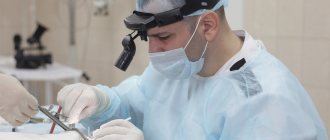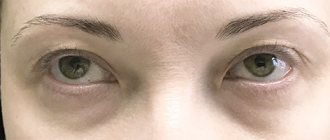Almost every person has facial asymmetry. As a rule, the right and left sides have differences, however, for some, the severity of this disorder is high, while for others it is almost invisible. Sometimes asymmetry is especially pronounced on only one side, provoking the development of mental disorders and social discomfort in a person. Asymmetry is a pathology that involves different degrees of development of the visual organs. As with facial asymmetry, pathology can occur to a greater or lesser extent.
The nature of this violation can be very diverse. The disease is simultaneously a dermatological, dental, cosmetic and neurological ailment. We will consider all the issues related to eye asymmetry, including signs of deformation and the reasons for its occurrence, and also try to answer the question of why the disorder is observed in one eye.
Causes of pathology on the face
It is known that facial asymmetry is a congenital or acquired pathology. In this regard, the following reasons for the appearance of pathological changes in humans can be noted. As congenital ones, the following are distinguished:
- structural defect of the temporomandibular zone;
- anomalies in the structure of the skull;
- pathological changes in the area of formation of neck muscles on one side;
- general disturbance in the development of the lower jaw row;
- pathologies of connective or muscle tissue.
If we are talking about acquired symmetry, then the causes of pathology may be the following:
- injury or inflammation of nerve endings in the facial area;
- visual defects or strabismus;
- if one of the jaws has no teeth;
- the presence of a permanent disease in the connective tissue, as well as as a result of changes in its parameters;
- negative habits such as chewing gum, squinting your eyes, or sleeping on one side.
In childhood, eye asymmetry also occurs and can develop as a result of complex pathological processes in the child’s body. In some cases, facial asymmetry develops with the gradual aging of a person, as well as in the presence of underlying diseases.
What to do if after blepharoplasty your eyes are different sizes?
Many patients are in a hurry to evaluate changes in their appearance almost immediately after plastic surgery, without taking into account the rate of resorption of edema, hematomas and the individual characteristics of healing of injured tissue. Meanwhile, such intermediate results can cause serious stress for an impressionable person.
Eyes of different sizes after blepharoplasty are a frequent cause for concern during the rehabilitation period. Typically, this condition is caused by changes in the shape or relative position of the eyelids, and this can be either an absolute norm or a complication. Is it worth sounding the alarm at the sight of any irregularities and preparing for a repeat operation? We read the material TecRussia.ru and act as necessary:
↑ Reasons for the development of eyelid asymmetry
The situation when during the first weeks and even months after blepharoplasty one eye is wider and the other is narrower is quite common. Behind the external manifestation of the problem there may be a number of reversible and irreversible changes in tissues:
- The main and most common cause of differences in the size and/or shape of the palpebral fissures is postoperative swelling. In the case of eyelid surgery, they are quite durable and can dissolve for up to six months, and sometimes even longer. Uneven accumulation of fluid in the area of the right and left eyes almost always leads to the fact that either the eyelids are at different heights, or their shape is deformed, or the incision on one side becomes narrower than on the other. But as the swelling subsides, the eyes will also return to normal and the problem will resolve itself.
More serious factors that may require additional corrective procedures and sometimes reoperation:
- The appearance of persistent ptosis of the upper eyelids. Due to severe swelling, it is almost always present to one degree or another in the first months of rehabilitation, but normally should gradually go away. Unfortunately, sometimes this does not happen completely, and if ptosis still persists within ~6 months after the operation, it will not go away by itself.
- Uneven facial expressions, when the muscles on one side are more developed than on the other - this feature could have been present for a long time and became more noticeable after surgery, or developed already during the recovery period (for example, as a result of the ptosis described above).
- Uneven structure of the facial part of the skull, and this applies to both soft tissues and bone structures. In this case, a slight difference in the size or shape of the eyes was likely noticeable before surgery, but became much more obvious after surgery.
- The formation of rough scars that unnecessarily tighten the tissues of the eyelids or change the shape of the palpebral fissure. An interesting fact: the slight, barely noticeable difference between the height of the upper eyelid folds may be due to which hand the surgeon uses. Right-handed people make a slightly less careful cut on the left side, and vice versa - but if the scarring proceeds without complications, from the outside everything will look perfectly smooth.
- Surgeon errors during the preparation and conduct of the operation: excision of too much or insufficient amount of skin, injury to muscle fibers or tendons, careless suturing, etc.
↑ Complication or not? How long does it take for your eyes to return to normal?
The speed at which tissue repair occurs after injury varies from person to person. However, there is a practice-tested general rehabilitation scheme that you can follow and, in case of obvious deviation from it, consult with your plastic surgeon:
↑ First 10-14 days after surgery
During this period, it is better not to look at yourself in the mirror at all. Tissue swelling goes away slowly and unevenly. Hematomas are “blooming” with might and main. The seams on the eyelids can be located at different levels, once again emphasizing the differences in eye sizes. However, all these troubles are not considered a deviation from the physiological norm. There are no reasons for frustration or tears: most likely the reason is asymmetrical swelling. Factors contributing to its appearance:
- sleep lying on your side or on your back with your head turned to one side;
- anatomical features of the location of veins and lymphatic vessels, which determines different rates of outflow of excess fluid from tissues;
- uneven tissue damage, resulting in more swelling on one side;
- bending over, lifting weights;
- non-compliance with doctor's recommendations regarding drinking regime.
↑ Period from 2 weeks to 2 months after eyelid surgery
In the second or third week, swelling begins to actively resolve. This does not mean that the palpebral fissures will immediately acquire ideal symmetry. But normally, the eyelids should gradually level out. If the right eye becomes more and more similar to the left, the excess fluid disappears, and there are no large folds or ridges on the skin around it, then everything is fine, you just need to be patient and allow the tissues to fully recover.
By the end of the second month, it becomes finally clear whether the asymmetry was caused by edema or other reasons that can lead to the formation of a permanent defect. If the result at this stage of the rehabilitation period is not satisfactory, you need to contact your plastic surgeon to:
- Be examined for more serious complications (signs of ptosis, problems with facial muscles, etc.);
- If everything turns out to be in order, get recommendations regarding the care of your eyelids.
Typically, manual and physical therapy procedures are prescribed to speed up the healing process. But you shouldn’t start doing eyelid massage on your own or sign up for hardware cosmetology at a salon. Such amateur activities can, at best, not produce results, and at worst, even cause harm. It is advisable for the cosmetologist to work closely with your plastic surgeon, then the result will be more predictable.
↑ Period from 2 to 6 months after plastic surgery
It is at this time that it finally becomes clear - either the operation was successful, or the eyes will remain different: one is wider, the other is narrower. The following conditions are considered problematic:
- unequal eye shape: for example, one is almond-shaped and the other is round, or one slit is significantly narrower than the other;
- the upper or lower eyelids are located at different levels, or on one side they do not fit tightly to the eyeball, do not open or do not close completely;
- the fold above the ciliary edge of the upper eyelid is deeper or located clearly higher than on the other side;
- the eyes on one side look more swollen than the other, there are skin deformations around that are not present on the eyelids on the opposite side;
- there are visible or tactile lumps in the operated area;
- at rest, the eyelids are the same, but when smiling, a clear asymmetry is visible: on one side the size or shape of the eye changes, skin folds appear.
At the same time, any conclusions should be drawn no earlier than after 4-6 months. In order to assess the real significance of the defect, it is necessary to take a number of photographs in different lighting and from different angles, experiment with decorative cosmetics and ask questions to close people whose objectivity there is no doubt about.
- Details about the main complications after blepharoplasty
- Eyelid lift without surgery: what techniques do our experts recommend?
↑ Methods for correcting eyelid asymmetry after blepharoplasty
If you have any concerns or questions regarding the results of your surgery, you should contact your plastic surgeon, get their recommendations, and follow them strictly. If there are reasonable doubts about the qualifications of the operating doctor, you can contact another, more authoritative specialist.
Depending on the reasons for the defect and how severe it is, an appropriate correction method is selected - from decorative cosmetics to repeated surgery. The most effective are considered:
- Massage. Manual or hardware treatment of the face and eyelids allows you to restore muscle tone and accelerate the outflow of venous blood and lymph. This helps eliminate swelling, remove toxic waste products from the body, which are formed in excess in injured tissues, and provides an influx of oxygen and nutrients, which accelerates healing. It is only important not to prescribe such procedures yourself, but to agree on their type and frequency with the surgeon: a lot depends on the individual characteristics of the body and how the rehabilitation proceeds.
- Microcurrent therapy (MTT). This physiotherapy procedure is most often used when it is necessary to tone muscles and restore their activity. In the case of blepharoplasty, it will help if the difference in the size or width of the eyes is due to uneven facial expressions or unsuccessful scarring, since currents promote the resorption of fibrous tissue.
- Botox. Botulinum toxin injections allow you to even out the tone of the facial muscles that move the eyelids of the right and left eyes. This is a good alternative to surgical correction if the asymmetry is not very pronounced and is caused precisely by different muscle activity on different sides of the face.
- Repeated operation. Unfortunately, this is not such a rare thing among those who once decided on blepharoplasty. Almost always allows you to solve problems caused by rough scarring and restore the symmetrical shape of the palpebral fissures. It is much more difficult to correct defects associated with the removal of excess skin. Only experienced doctors can be trusted to perform such an operation, since the likelihood of developing new complications (non-closure or inversion of the eyelid, scars, etc.) increases. And the repeated intervention itself is technically always much more difficult than the first.
However, before you think about correction and, moreover, go under the scalpel, you need to determine for yourself whether the eye is actually “somehow different” and the asymmetry is really noticeable to others, or whether the problem is more psychological, associated with inflated expectations and an overly emotional assessment of the result.
Experts' opinions:
Bytdaev Zaur Makhrovich Plastic surgeon, Candidate of Medical Sciences
In my practice, such a situation has not arisen after the rehabilitation period, but immediately after surgery it can arise due to varying degrees of swelling. To get rid of this condition as soon as possible, there is a set of measures that can effectively resolve the issue, including physical therapy. True, it is necessary to take into account that there is congenital asymmetry, which is really noticeable, but in some cases it can also be corrected.
During the first month after surgery, the difference in eye size can be considered normal. For everything to go well, you must strictly follow all recommendations and do not skip secondary examinations, because... the surgeon keeps the rehabilitation process under control. If at the end of the recovery period there is no positive dynamics, then this is a complication. The first thing the patient should do in this case is to contact his doctor to determine the causes and find a solution. It can be different: revision blepharoplasty, canthoplasty or other types of surgical intervention.
Aleksanyan Tigran Albertovich Plastic surgeon, Candidate of Medical Sciences
Eyes of different sizes occur due to inadequate surgical intervention or very asymmetrical facial variations. I believe that first of all you need to choose the right surgeon who has been performing these operations for many years and knows how to do it in order to avoid such a result. Otherwise, the intervention will have to be repeated, which greatly complicates the correction of the consequences.
Levin Sergey Lvovich Plastic surgeon, Doctor of Medical Sciences
Usually, in any person, the eyeball is more recessed on one side, and more protruding on the other and visually appears larger - this is the norm. After upper eyelid surgery, the difference sometimes becomes even more noticeable. Another significant factor is that after the operation the patient examines herself longer and more closely in front of the mirror and finds that asymmetry that she did not notice before. A less pleasant option is that if too much skin around the eyes is removed, then the difference in the depth of their seating may be amplified. And this, unfortunately, is already irreparable.
Egorova Maria Vladimirovna Leading plastic surgeon Frau Klinik
Initially, both our skull as a whole and our eyes in particular are asymmetrical. However, almost no patient notices this. After surgery, a difference may appear due to closer attention to the area, as well as the inevitable swelling. In general, the rehabilitation period takes about 6 months, during which time there may be various complaints about the area of surgery that do not require additional intervention. Different eyes are considered a complication if the asymmetry is caused by improperly performed blepharoplasty. In some cases, correction is possible, but its feasibility can only be determined individually, during a face-to-face appointment.
Symptoms of pathology
As a rule, with facial asymmetry, the problem is externally manifested in the fact that the right side is wider than the left. If a citizen has natural asymmetry, then the discrepancy in size between the sides can be completely insignificant in the form of 2-3 mm. This appears as a slight deformation. The patient's disturbances are expressed as follows:
- the damaged half of the face is characterized by weakness of the facial muscles and takes on the appearance of a mask;
- folds in the forehead, nose and lips are less noticeable;
- the palpebral fissure widens significantly;
- at the mouth the corners change direction (directed downwards);
- the damaged area gives the face a distressed appearance;
- the facial muscles lose their mobility, and the patient can no longer close his eyes normally or wrinkle his forehead;
- a sick person speaks poorly and cannot eat normally because it simply falls out of the mouth;
- Painful sensations often appear in the damaged area.
In children, the disorder appears when the child lies on only one side for a long time. As a rule, the face takes on a flat shape in the cheek area, and the head tilts to the injured side.
What do experts think?
Bytdaev Zaur Makhrovich, plastic surgeon, candidate of medical sciences:
In my practice, after the recovery period there was no such problem, but immediately after the operation it can appear due to varying degrees of swelling. In order to get rid of this condition as quickly as possible, there is a list of measures that can effectively resolve the issue, including physical therapy. True, it is necessary to take into account that there is a congenital asymmetry, which is actually visible, but it can also be corrected.
Eye size difference
During the first month after surgery, differences in eye size can be considered normal. In order for everything to go smoothly, you need to strictly follow the surgeon’s recommendations and go for repeated examinations, since the doctor must monitor the rehabilitation process. If, upon completion of rehabilitation, no positive dynamics are observed, then this is considered a complication.
The first thing a patient should do in such a situation is to go to his surgeon to identify the causes and find a solution. Repeat blepharoplasty, canthoplasty, and other types of surgery may be necessary.
Aleksanyan Tigran Albertovich, plastic surgeon, candidate of medical sciences:
Eyes of different sizes occur when the operation is performed incorrectly or when the face is very uneven. I believe that first you need to choose the right surgeon, who has been performing such operations for a long time and knows how to do it, so as not to encounter unpleasant consequences in the end. Otherwise, you will have to do a second operation, which makes correcting the consequences much more difficult.
Levin Sergey Lvovich, plastic surgeon, Doctor of Medical Sciences:
Usually, in any person, the eyeball is more recessed on one side, and more protruding on the other and visually appears larger - this is a normal phenomenon. After upper eyelid surgery, the difference sometimes becomes more noticeable.
Another main factor is that after the operation the patient examines himself longer and more closely in front of the mirror and finds that asymmetry that he did not notice before. A less pleasant option is that if too much skin around the eyes has been excised, then the difference in the depth of their seating may be increased. And it can't be fixed.
Egorova Maria Vladimirovna, chief plastic surgeon at Frau Klinik:
Initially, the human skull as a whole and the eyes are asymmetrical. But almost no patient notices this. After surgery, a difference may occur due to close attention to the area as well as swelling. In general, recovery lasts 6 months; during this time, various complaints may arise regarding the operated area, which does not require additional intervention.
Different eyes are a complication if asymmetry was obtained due to incorrectly performed blepharoplasty. In some situations, correction is possible, but its feasibility can only be determined during a face-to-face consultation with a surgeon.
YouTube responded with an error: The request cannot be completed because you have exceeded your quota.
Rate this article:
- Related Posts
- How to remove seals on the lower eyelid after blepharoplasty?
- What to do if your eyes are pulled after blepharoplasty?
- What to do if ptosis appears after blepharoplasty?
- Why did bumps form after blepharoplasty?
- Why do black circles appear after lower blepharoplasty?
- Is blepharoplasty dangerous?
Why is one eye larger than the other?
Facial asymmetry is sometimes determined by one eye. The larger one eye is to the other, the higher the likelihood of the patient having pathology. Asymmetry especially often appears during periods of inflammation or during the development of various infectious diseases. Let's look at a few ways in which one eye can become larger than the other.
| Cause | Manifestations of the disease |
| Infection | A disease of this nature has a negative effect on the condition of the eyelid, causing swelling of the eyelids and other pathologies. A group of such diseases includes conjunctivitis or barley. Inflammation negatively affects the mucous membrane, after which one eye becomes smaller, however, this occurs almost immediately after the infection disappears from the body. It is important to support the body during this period by taking various medications. In case of complications, the asymmetry may increase. |
| Injury | A bruise or abrasion can lead to swelling of the eye, and therefore a change in the angle of vision. In this case, it is necessary to urgently visit a specialist, where a specific treatment option for the disease will be offered. |
| Bulbar syndrome | The disease develops due to complications of brain diseases. This causes deformation of the eyes, and can also cause pain and disruption of the functioning of the eye muscles. |
| A brain tumor | Malignant tumors can also act as a cause of asymmetry. If there is no reason for the problem to arise, then you should consult a neurologist. |
| Inflammation of the trigeminal nerve | Inflammation, which leads to discomfort in the ear area and severe migraines. |
Causes of eyelid asymmetry
The situation when during the first weeks and even months after blepharoplasty one eye is wider and the other is narrower is a fairly common occurrence. Behind the external manifestation of the problem there may be a whole list of reversible and irreversible changes in tissues. The main and most common cause of asymmetry of the palpebral fissures is postoperative swelling. When performing eyelid surgery, they are quite stable and can resolve within six months, sometimes longer.
Uneven accumulation of fluid in the area of the right and left eyes almost always leads to the fact that either the eyelids will be at different heights, or their shape will be deformed, or the incision on one side will be narrower than on the other. But as the swelling subsides, the eyes will also return to normal, and the problem will resolve itself. More serious causes that may require additional corrective procedures and sometimes reoperation:
- formation of persistent ptosis of the upper eyelids. Due to severe swelling, ptosis is present to any degree in the first months of recovery, but normally it should gradually go away. Alas, sometimes this does not happen completely, and if ptosis still persists within 6 months after the operation, it will not go away on its own, it needs to be removed;
- uneven facial expressions, when the muscles on one side are more developed than on the other - this feature could have been present for a long time and became obvious after surgery or developed already during the rehabilitation period;
- uneven structure of the facial part of the skull, and this applies to soft tissues and bone structures. In this situation, a small difference in the size or shape of the eyes was likely visible before surgery, but became much more noticeable after surgery;
- creating rough scars that strongly tighten the tissues of the eyelids or change the shape of the palpebral fissure. It is noteworthy that the small, barely visible difference between the heights of the upper eyelid folds may be related to which hand the surgeon has the dominant hand. Corrections make a slightly less neat cut on the left side, and vice versa - but if the scars are healed without complications, outwardly everything will look perfectly smooth;
- errors by the surgeon at the time of preparation and performance of the operation: removal of too much or insufficient amount of skin, injury to muscle fibers or tendons, incorrect suturing.
We recommend: How to get rid of dark circles under the eyes after blepharoplasty?
How is the disease diagnosed?
To begin treating the pathology, it is necessary to conduct a diagnosis and make an accurate diagnosis. As a rule, to identify an illness, the doctor first visually examines the patient’s face for the presence of pathologies of muscles, teeth or nerve endings. After a visual examination, the specialist talks with the patient regarding hereditary pathologies, as well as the presence of serious injuries.
At the next stage, it is necessary, using a measuring device, to determine the proportions of the face and identify damage or deformation. The pathological disorder starts from 3 mm or 5 degrees. To definitively check for the presence of asymmetry, a drawing of the patient's face is performed using two right or left sides. The result is two identical images, which may have striking differences from the patient's face.
How to recognize pathology?
The main goal of diagnosing ptosis of the upper eyelid is to establish the cause that led to the development of this disease.
- Assess the position and mobility of the eyelid.
- Assess the symmetry of eye movements.
- Assess eyebrow mobility.
- Determine the size of the eyelid fold.
- Determine the strength of the muscle that lifts the upper eyelid.
- Determine the presence of strabismus, amblyopia.
- Check your vision.
- Measure intraocular pressure.
If ptosis is caused by mechanical damage, the doctor should check the bone structures for damage. To do this, you need to conduct a survey x-ray. If there is a suspicion that ptosis has appeared due to problems with the nervous system, then a computer or magnetic resonance imaging of the brain is performed, and a referral to a neurologist and neurosurgeon is given.
- General clinical blood test. It will show leukocytosis and accelerated erythrocyte sedimentation characteristic of inflammation.
- Biochemistry of blood. This laboratory test will help identify cytolytic enzymes. Their level increases if there is destruction of cells and tissues in the body.
- General ophthalmological examination. As part of it, visual acuity is measured using Sivtsev tables.
- Perimetry. This is a method for determining peripheral vision and the degree of its impairment.
- Ophthalmoscopy. Using a slit lamp, the technique examines the condition of the fundus of the eye, the exit point of the optic nerve, the vascular network, and the anterior and posterior chambers of the eye.
- Magnetic resonance and computed tomography of the head. These instrumental methods help to identify hemorrhages, foci of destruction or neoplasms in the cranial cavity.
- Measurement of cerebrospinal fluid pressure. At the same time, cerebrospinal fluid should be collected for microbiological examination.
We suggest you familiarize yourself with Mite disease in the eyelids
Procedure for treating eye asymmetry
To cope with the disease and return the patient to a healthy appearance, patients use various techniques. If the pathology is not very pronounced, then there is no need to correct such a violation. Treatment is prescribed strictly on an individual basis and depends on the cause of the pathology:
- If muscle tone is affected, a course of myostimulation and a gymnastic complex for the facial muscles can help. In addition, it is necessary to carry out a massage with an emphasis on the damaged areas;
- a certain external style (hairstyle, makeup) is selected for patients, and a mustache or beard is selected for patients;
- the doctor prescribes orthodontic treatment;
- use methods of maxillofacial surgery;
- use various methods of correction using plastic surgery;
In particularly difficult cases, when the disease is severe, special neurological treatment is prescribed in a hospital with full supervision by an experienced specialist.
Eye asymmetry is a complex disease that definitely requires proper treatment. After completing the treatment procedure, it is important to adhere to the doctor’s recommendations in order to eliminate problems with possible complications and the development of other diseases associated with eye asymmetry.
To learn more about eye diseases and their treatment, use the convenient site search or ask a specialist a question.
Options for correcting eyelid asymmetry after blepharoplasty
Any concerns or questions you may have regarding your surgical results should be addressed to your plastic surgeon, and their recommendations should be taken seriously. If you doubt the qualifications of the surgeon who performed your operation, you can consult another doctor.
It all depends on what causes the defect and how pronounced it is, so the appropriate method of correction is selected - from decorative cosmetics to repeated surgery. The most effective are:
- massage. Manual or hardware treatment of the face and eyelids helps restore muscle tone and accelerate the outflow of venous blood and lymph. This allows you to remove swelling, remove toxic decay products from the body, which occur in large quantities in damaged tissues, and provide an influx of oxygen and nutrients, which speeds up healing. It is important not to self-medicate, but to agree on the type of procedures and their frequency with the surgeon: a lot depends on the individual characteristics of the body and how the recovery period goes;
- microcurrent therapy. This physiotherapy procedure is most often used when you need to tone muscles and restore their activity. If blepharoplasty was performed, then this therapy will help if the difference in the size and width of the eyes is characterized by facial expressions or unsuccessful scarring, since currents resolve fibrous tissue;
- Botox. Botulinum toxin injections can improve the tone of facial wrinkles that move the eyelids of the right and left eyes. This is a good alternative to surgical lifting if the asymmetry is not pronounced and is characterized by different muscle activity on different sides of the face;
- reoperation. Alas, this is not such a rare thing among those who have once had blepharoplasty. Almost always allows you to solve problems caused by rough scarring and restore the smooth shape of the eye slits. It is much more difficult to correct defects associated with the removal of excess skin. Such an operation should only be trusted to professional surgeons, since the risk of new complications (non-closure or inversion of the eyelid, scars) increases. And the repeated intervention itself is technically more difficult than the first.
But before you think about correction and go under the surgeon’s knife, you need to determine for yourself whether the eye is actually uneven and the asymmetry is really visible to others, or whether the problem is psychological in nature, associated with inflated expectations and overestimation of the result.
We recommend: How to remove seals on the lower eyelid after blepharoplasty?









